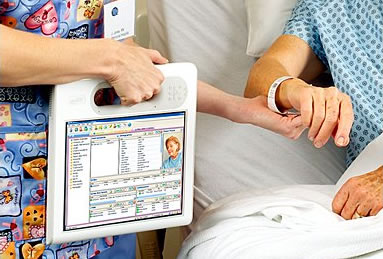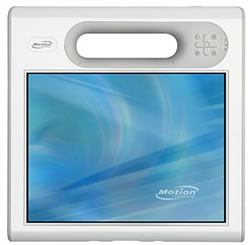Tablet PC to Replace Medical Charts

Ready for some scary statistics? Each year about 1.5 million people are injured due to medical mistakes, and about 90,000 are killed. Numbers like that make me want to write to Apple and tell them to stop releasing a cool new music player every few months, and make technology that could save lives. So I was totally psyched to see the C5 Tablet from Motion Computing developed for health care providers. It's a tablet computer with a built in barcode scanner, RFID reader, and camera. Plus it's fully sealed so it can be cleaned and disinfected. While a lot of really good thinking went into the device, the $2200 price tag will probably put it out of reach for most hospitals, especially the ones that need it most. Given that OLPC was able to make a $140 laptop, Motion and collaborator Intel could have tried a little harder to bring the price down. The main problem is that it runs full blown Windows, instead of Windows Mobile or a custom Linux build (like OLPC does). Read on for more on this.

If the device ran Windows Mobile or Linux it could have used much more modest hardware, like a less powerful (less expensive) processor and flash memory. Those changes would make the device more durable, the batteries last longer and most importantly cost less. Also, I don't know why a device like this should have a hard drive other than to support the OS. It seems to me the whole point of a health care tablet computer is to replace charts with real-time access to a patient data. So the last thing you'd want to do is save patient data to the hard drive in the device because it could go out of sync. Instead patient data should be stored and accessed on a secure web based application, which would not only ensure the data is in correct, but also lighten the processing load on the device. And if 802.11n were used for wireless networking the performance would be outstanding. Also, I'm not sure what kind of backlight it uses, a screen using LED backlighting could probably achieve better brightness at lower energy consumption. Of course, this also seems like a great use for the screen developed for the OLPC laptop which can run in a full color backlit mode, or a low power black and white mode.
Current HIPAA requirements may make storing data as I proposed impossible, but devices like the C5 are inevitably going to be seen as the solution to a whole range of health care management problems. Which basically means the HIPAA rules need to change.
Anyways, I'm sure volume discounts would allow most hospitals to pay far less for the device than the $2,200 list price. But still, this device is destined to be beaten by something technically more simple and a tenth the cost.
Medical Errors and Technology - NPR Talk of the Nation